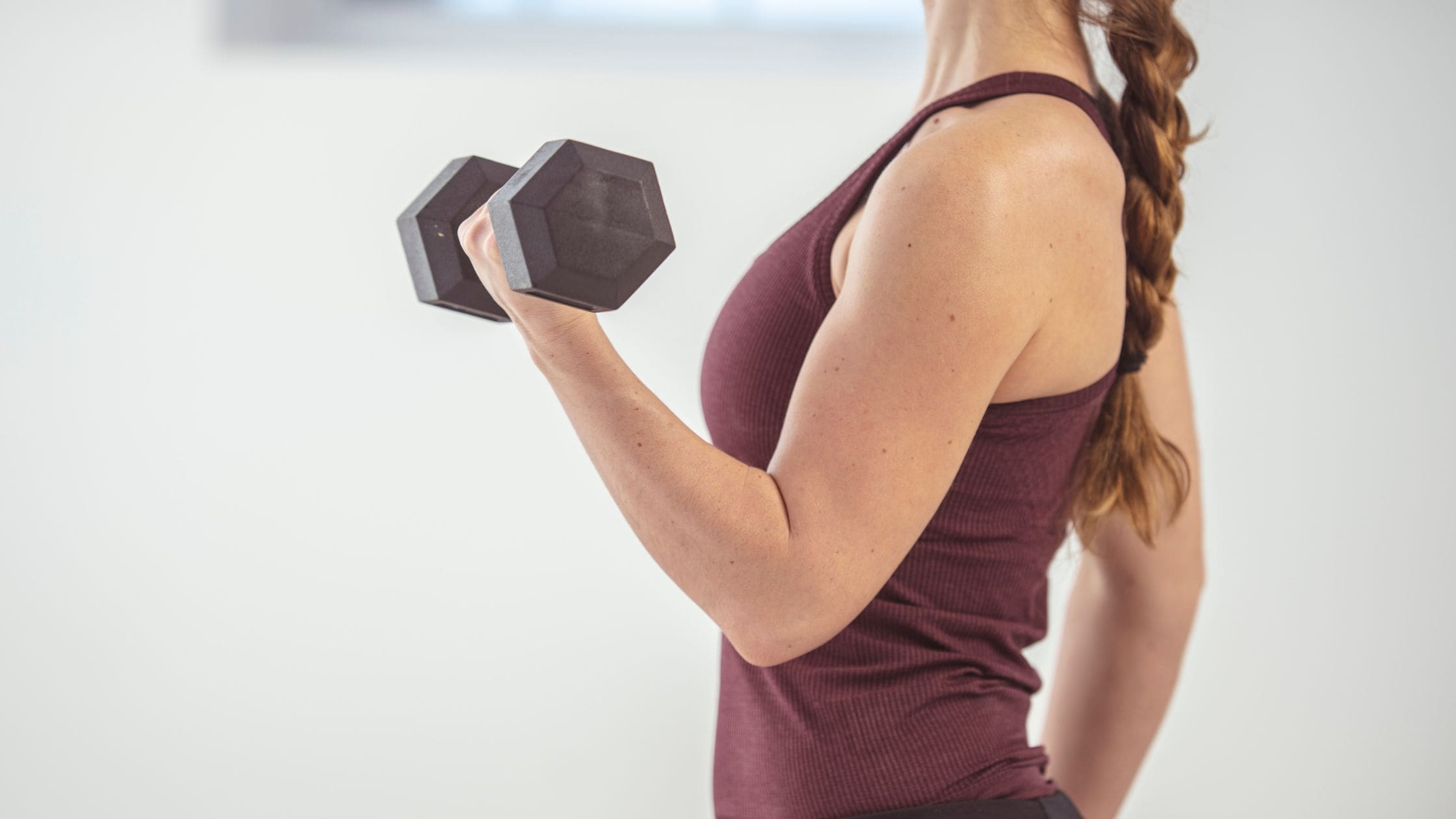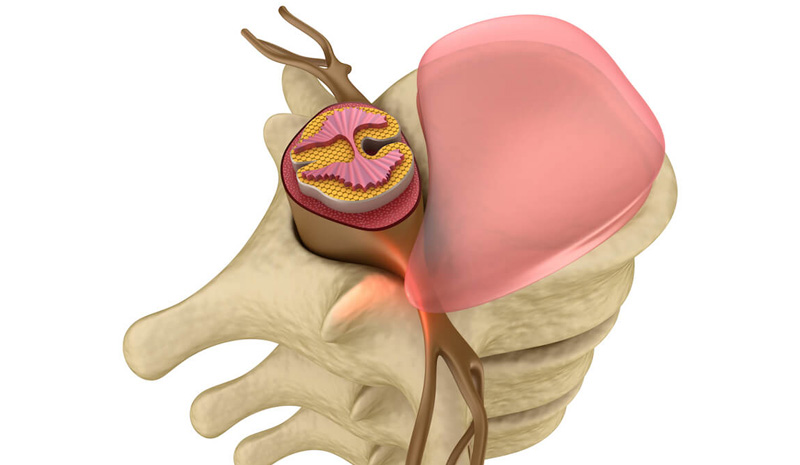Osteoporosis is a major worldwide health issue. In this country, 1 in 3 women and 1 in 5 men over the age of 50 will suffer an osteoporotic break of a bone. These breaks can be life-threatening and a major cause of pain and disability, particularly as we get older.
In this article, we’ll be discussing:
- What Osteoporosis and Osteopenia are
- The common causes and symptoms
- How to prevent and manage Osteoporosis
- Pilates and Osteoporosis
- Exercises to help Osteoporosis
- Exercises to avoid with Osteoporosis
What is Osteoporosis?
According to the NHS over 3 million people in the UK are affected by Osteoporosis, a condition which is often known as a ‘silent disease’. Essentially it weakens bones and makes them more fragile and likely to break. These breaks generally occur in the hip, spine and wrist but can happen in the arm or pelvis and as we get older can not only be painful but life threatening.
What is Osteopenia?
Osteopenia is the stage before Osteoporosis where the bone density is lower than what it should be but not low enough to be classed as Osteoporosis. Osteopenia may not necessarily lead to Osteoporosis and things like diet and exercise can reduce the risk of developing it. Bone strengthening medication can also be provided by a doctor depending on the risk level of bones breaking.
Diagnosing osteoporosis
Many people being investigated for osteoporosis will have their bone density assessed with a DEXA scan. This will give you a score for each area measured, this is usually the hip and spine. It can be confusing to understand the results of this test and it is important to remember it is only one of the factors that will influence the risk of fracture. This is a video explaining what the results mean and what other factors need to be considered.
What are the causes of Osteoporosis?
There are a number of factors which can cause Osteoporosis such as sex, age and race as well as lifestyle choices, certain medicines and health problems.
Below are just some risks factors:
- Sex – Women are much more likely to develop Osteoporosis than men.
- Age – The older you get, the greater your risk of Osteoporosis.
- Race – If you’re white or of Asian descent it’s more likely you are at greatest risk of Osteoporosis
- Low calcium intake – A lack of calcium can contribute to the development of Osteoporosis, diminished bone density and an increased risk of fractures.
- Eating disorders – Severely restricting food intake and being underweight weakens bones
- Sedentary lifestyle – People who spend a lot of time sitting have a higher risk of Osteoporosis than those who are far more active. Any weight-bearing exercise and activities that promote balance and good posture are beneficial for your bones as is walking, running and weightlifting.
- Medical problems – The risk of Osteoporosis is higher in people who conditions such as celiac disease, inflammatory bowel disease, cancer and rheumatoid arthritis for example
- Lack of oestrogen in the body – If you have an early menopause (before the age of 45) or a hysterectomy where one or both ovaries are removed, this increases your risk of developing Osteoporosis. Both can cause your body’s oestrogen production to reduce dramatically, so the process of bone loss will speed up.
Related reading: Pilates for menopause – is it beneficial?
You can find out if you’re at risk of Osteoporosis by completing the Royal Osteoporosis Society’s online test.
What are the symptoms of Osteoporosis?
Although there are no real symptoms in the early stages of bone loss, once they become weak certain symptoms of osteoporsis to look out for might include:
- Loss of height over time
- A stooped posture
- A bone that breaks much more easily than expected
- Back pain, caused by a fractured or collapsed vertebra
Finding out more about your risk factors for Osteoporosis as outlined above can help you identify if you could be prone to it before you break a bone. Crucially, you may notice something you can change to protect your bones.
How can exercise prevent Osteoporosis?
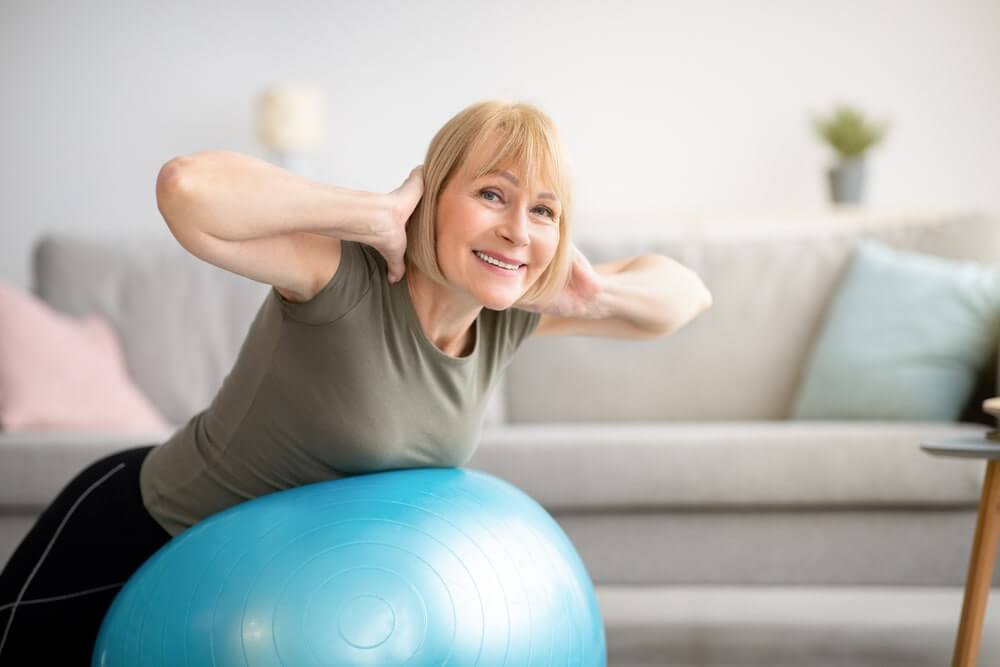
Bones respond to loading. This means that they will adapt to what we are asking them to do.
The biggest time for change in our bones is during our teenage years when our skeleton is fully developing. This is the time when we can make the most gains in terms of bone density; by increasing our bone density we can help to prevent fragility and breaks when we are older.
The most important type of exercise is going to be anything that loads your bones. This includes impact exercises such as running, tennis, dancing, football, netball, gymnastics, weights. Basically, anything where you are putting weight bearing load through your bones is a good idea.
These kinds of exercises stimulate the bones to develop and increase in density as they respond to the forces being put through them. They respond best to a variety of loading, so a mixture of sports using upper and lower body is best. Get your teenagers out and exercising as much as possible to look after their bones later in life!
Management of Osteoporosis
If you’re diagnosed with Osteoporosis, there are ways in which you can manage pain and reduce your risk of further fractures.
Your healthcare team may suggest you take medication, make changes to your diet, or tell you to do more exercise such as walking or Pilates.
It’s important to remember that regular exercise and a healthy diet are both vital for everyone, not just those who have osteoporosis. Make sure you have a balanced diet that contains all the food groups to give your bones the nutrition they need and exercise in a way you can to strengthen your body, keep you steady and your back supported.

The International Osteoporosis Foundation Campaign gives these 5 steps to healthy bones and a fracture-free future:
- Exercise regularly.
- Ensure a diet rich in bone-healthy nutrients.
- Avoid negative lifestyle habits.
- Find out whether you have risk factors.
- Get tested and treated if needed.
How can exercise help to manage Osteoporosis?
People with Osteoporosis may be told that they need to be cautious of their bodies in order to prevent fractures or broken bones whilst also being told to exercise as a way to stay healthy. This can be confusing for sufferers but the right sort of exercise, such as clinical Pilates, can be of huge benefit.
Combining physiotherapy and Pilates together is a great way to manage osteoporosis but also maintain good posture and strengthen the supportive muscles around the spine and hips. It’s also an effective symptom relief for anyone suffering with a broken bone.
Pilates designed for Osteoporosis management generally focus on strengthening the antigravity muscles (calves, glutes, spinal extensors and triceps) which in turn helps to keep your body upright by maintaining good posture and supporting your bones. People who have osteoporosis and hunched spines are more likely to suffer breaks and so reducing quality of life. Therefore, it’s vital to carry out exercises to maintain posture and obtain a well-aligned spine.
Is Pilates good for osteopenia?
As with osteoporosis if you have osteopenia then exercise such as Pilates will help to strengthen your bones and muscle strength and improve balance therefore help to reduce your chances of falling.
It’s always a good idea to talk with your doctor or specialist osteoporosis physiotherapist or do not hesitate to contact our clinical Pilates instructors about the best and safest exercises for you.
Our Pilates programme for osteoporosis
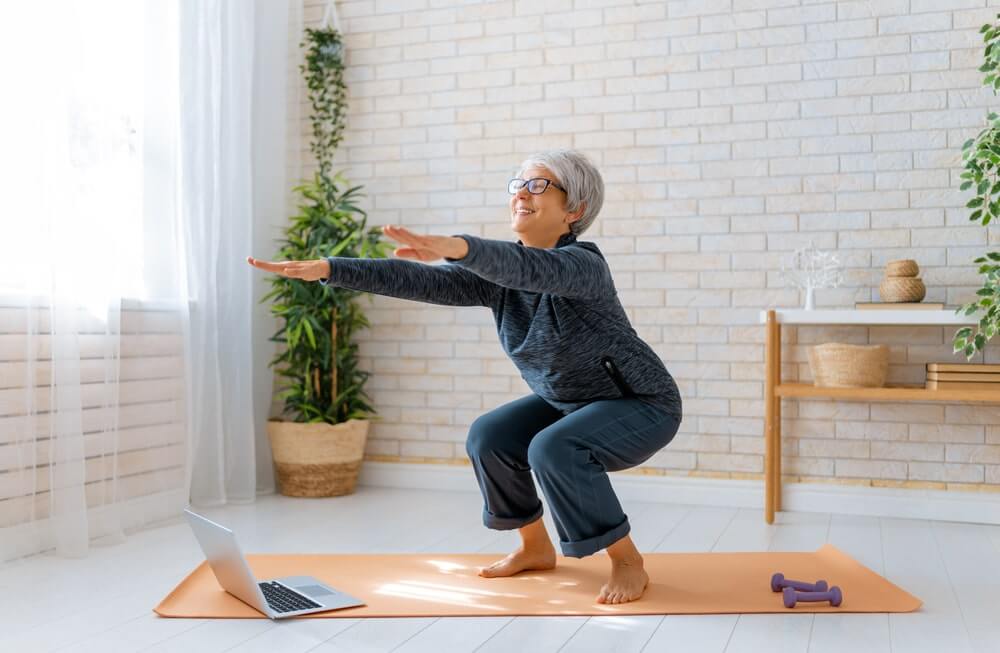
If you have been diagnosed with osteoporosis or osteopenia and would like to exercise in a managed and controlled environment to maintain your bone density, reduce the risk of fracture and maintain your activity levels, we have developed a 6 week Pilates and osteoporosis programme for management and prevention.
This course is led by Ruth Smith, Physiotherapist and osteoporosis specialist.
The 6 week Pilates and osteoporosis management programme includes:
- 8 week access
- 6 long classes (approx. 1 hr)
- 6 short classes (approx 15 mins)
- 3 masterclasses
- Information pieces on understanding your diagnosis and scan results, exercise for osteoporosis and living with osteoporosis
- Links to vlogs and podcasts which may help
- A FREE 15 minute phone call to discuss how this could help and if it is appropriate for you
For more information, explore our Physio Led Pilates at Home On Demand service see link or sign up today.
4 Pilates exercises for Osteoporosis
Below are four simple Pilates exercises which you can do at home, in your own time and space, to help you manage your osteoporosis. They are all safe, provided you are pain-free and mobile. We would advise you to aim to do these at least three times a week to feel the difference.
1. Standing Footwork
This exercise is great for challenging your balance, coordination and strengthening those important anti-gravity muscles;
- Firstly stand tall.
- Push your hips back into a small squat and then lift your heels and press the ball of the foot into the floor.
- Straighten the knees and then lower the heels.
- Repeat x 15
2. Scooter
This exercise is a fantastic exercise which helps to challenge your balance and strength through the spine and hips.
- Bend the knee of the standing leg slightly and lean forward a little
- Maintain a neutral spine and engage the core
- Exhale to press the leg that isn’t bent away using the inside leg, straightening that leg and inhale as you control it back in.
3. Press ups
Press ups help to strengthen the triceps which in turn reduces the risk of wrist fractures.
- Come into all fours with your hands under the shoulders and the knees under the hips.
- Lean forward as you bend the elbows along the line of your body so that you feel your upper arms working as your chest lowers and then lifts again.
- Aim to maintain your spine in the same posture throughout.
- Repeat x 15
4. Dart
- This move works the strength down the back of your body to keep your spine upright, protect the spinal bones and help with balance.
- Start by lying on your front. If it’s comfortable, rest your forehead on a small, folded towel. Arms are by your side.
- Now, imagine that your body is being stretched as tall as possible from the crown of your head down to your tailbone.
- Roll the shoulders back to open up the collar bones and hover the hands.
- Next, allow the head and chest up to come off the floor – this will work the upper back. Remember: you shouldn’t feel any pain or strain in the lower back.
- Slowly lower back down
- Repeat x 10
Pilates and osteoporosis exercises to avoid
If you have osteoporosis there are certain movements which you need to avoid during exercise, particularly forward bends (flexion) of the spine or rotation when bending forwards to reduce the risk of harming your vertebrae.
Traditional Pilates sessions that have not been adapted for osteoporosis can include these forward bending movements which means you need to ensure your instructor knows about your diagnosis and is trained in teaching and modifying movements for it.
As already mentioned, you should mainly focus on working on your strength and balance. You should consult with an exercise specialist, like a specialist osteoporosis physiotherapist or clinical Pilates Instructor for individual advice.
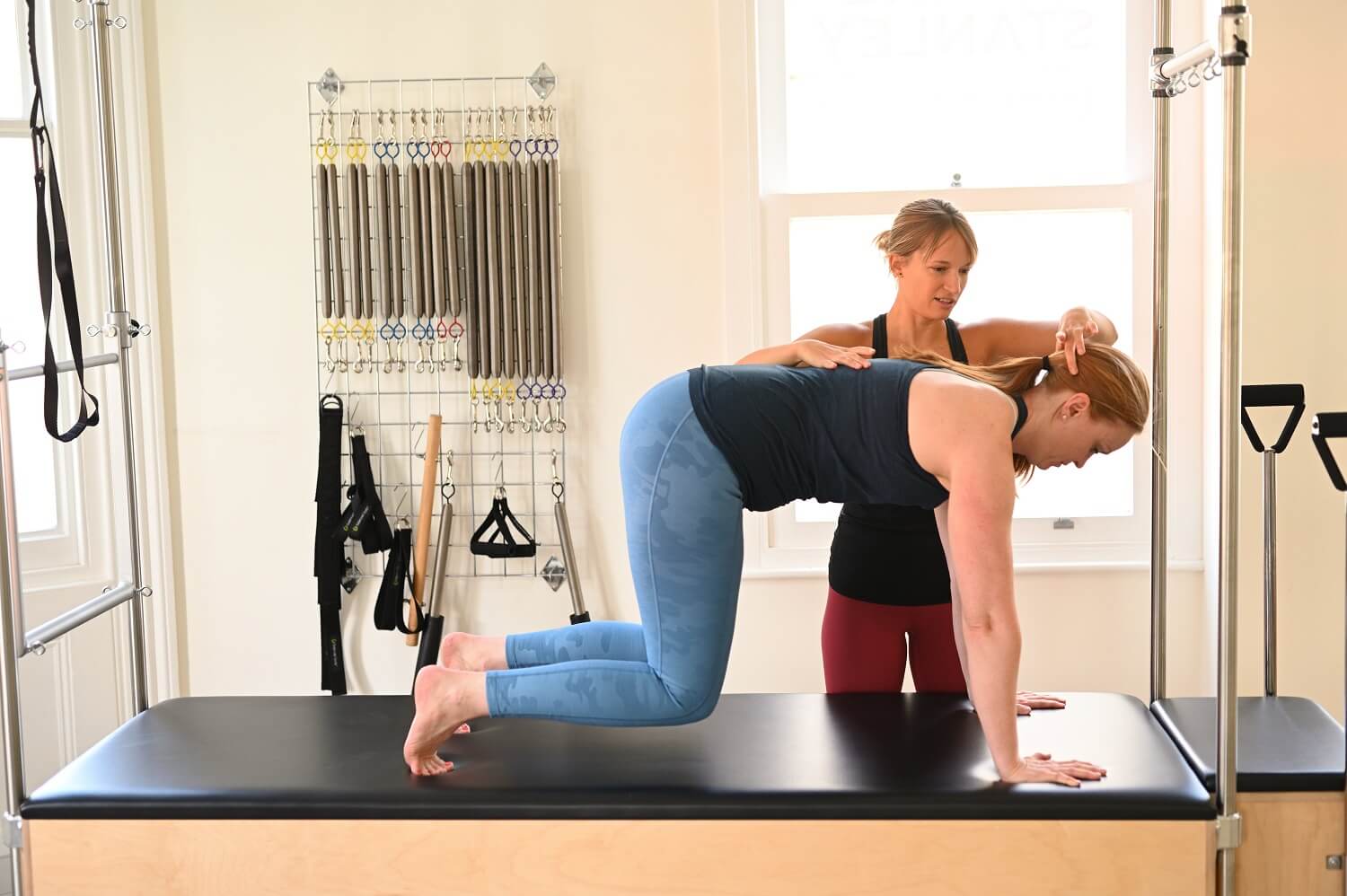
Our on-demand osteoporosis Pilates course
At Complete Pilates, we specialise in clinical, physio-led Pilates to help both women and men who have osteoporosis. If you want to exercise more to maintain your bone density, reduce the risk of fracture and maintain your activity levels throughout your life then our on demand Osteoporosis Pilates course can help.
Our physiotherapist and Osteoporosis specialist, Ruth Smith leads the 6-week course at Complete Pilates. For more information or to sign up, please click here.
If you have concerns about osteoporosis, talk to a clinical Pilates instructor. Our team at Complete Pilates are all trained to safely treat clients with concerns regarding their bone health. We can create manageable, appropriate, on-going exercise plans to keep you healthy and fracture-free. These can be done in person in one of our three London studios or online.
We are also able to refer you to other specialist partners if we feel you are at higher risk and need further investigations or medical input.
- You can also complete an easy online fracture risk assessment at https://www.sheffield.ac.uk/FRAX/
- You can find out more about osteoporosis at www.nos.org.uk or www.iofbonehealth.org
Get in touch online or contact us on 0203 764 5668 for further information in order to manage your osteoporosis, reduce your risk of breaking bones, therefore enhancing your wellbeing, or simply to want to talk to someone about your diagnosis of osteoporosis.
These blogs are designed to give information to everyone, however, it is important to remember that everyone is different! If you have not seen one of our therapists and have any questions about injuries, what you have read or whether this may be useful to you, please just ask. We are more than happy to help anyone and point you in the right direction. Our biggest belief is that education is key. The more you understand about your injury, illness and movement, the more you are likely to improve.



